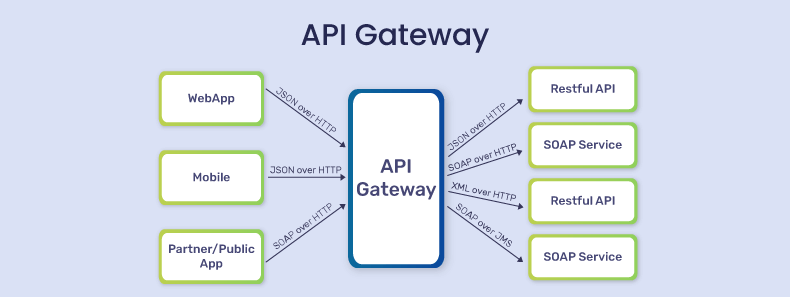In today’s world of microservices and cloud computing, API Gateways play a crucial role in managing traffic, enhancing performance, and securing APIs. With an increasing number of services interacting through APIs, it becomes essential to regulate API calls efficiently while preventing security threats and unauthorized access.
🚀 What is an API Gateway?
An API Gateway is a server that acts as an intermediary between clients and backend services. It processes requests, enforces security policies, manages traffic, and ensures efficient load distribution across microservices.
🎯 Key Responsibilities of an API Gateway
- Traffic Management – Distributes and balances API calls.
- Security Enforcement – Implements authentication and authorization.
- Rate Limiting & Throttling – Prevents abuse by controlling the number of requests.
- Logging & Monitoring – Tracks API usage and detects anomalies.
- Protocol Transformation – Converts requests and responses between different formats (e.g., REST to GraphQL).
⚡ Managing Traffic with API Gateways
APIs often experience high traffic from different sources. Without proper management, this can lead to server overload, slow response times, and system crashes. API Gateways help by implementing various traffic management techniques.
🔄 Load Balancing
API Gateways distribute incoming traffic across multiple backend servers to ensure high availability and optimal performance.
Example: Configuring Load Balancing in Kong
curl -i -X POST http://localhost:8001/upstreams \
--data name=my-upstream
curl -i -X POST http://localhost:8001/upstreams/my-upstream/targets \
--data target=service-1:8000 \
--data weight=50
curl -i -X POST http://localhost:8001/upstreams/my-upstream/targets \
--data target=service-2:8000 \
--data weight=50⏳ Rate Limiting and Throttling
Rate limiting prevents abuse by restricting the number of requests a user or application can make within a given time frame.
Example: Enabling Rate Limiting
curl -X POST http://localhost:8001/services/my-service/plugins \
--data name=rate-limiting \
--data config.second=5 \
--data config.hour=1000📦 Caching for Performance Optimization
API Gateways can cache frequent responses to reduce load on backend services and improve response times.
Example: Enabling Response Caching
curl -X POST http://localhost:8001/services/my-service/plugins \
--data name=proxy-cache \
--data config.strategy=memory🔒 Securing APIs with API Gateways
Security is a major concern for APIs, as they are vulnerable to attacks like DDoS, SQL injection, and unauthorized access. API Gateways provide multiple layers of protection.
🔑 Authentication and Authorization
API Gateways implement various authentication methods, such as:
- OAuth 2.0 – Secure access tokens for authentication.
- JWT (JSON Web Tokens) – Token-based authentication.
- API Keys – Unique identifiers for API access.
Example: Enforcing API Key Authentication
curl -X POST http://localhost:8001/services/my-service/plugins \
--data name=key-auth🛡️ Enabling SSL/TLS Encryption
API Gateways ensure data privacy by enforcing HTTPS (SSL/TLS) encryption.
Example: Enabling HTTPS on Kong
curl -X PATCH http://localhost:8001/services/my-service \
--data protocol=https🚧 Web Application Firewall (WAF)
WAF protects against malicious attacks like SQL injection and cross-site scripting (XSS).
Example: Adding WAF Protection
curl -X POST http://localhost:8001/services/my-service/plugins \
--data name=acl \
--data config.whitelist=trusted-clients📊 Comparison of API Gateway Features
| Feature | Benefits |
|---|---|
| ⚡ Load Balancing | Distributes traffic to prevent server overload. |
| 🔒 Authentication | Enforces secure API access using OAuth, JWT, etc. |
| 📉 Rate Limiting | Prevents API abuse by controlling request rates. |
| 💾 Caching | Speeds up responses and reduces backend load. |
| 📊 Monitoring | Tracks API performance and detects anomalies. |
🎯 Conclusion
API Gateways are an essential component for traffic management and security in modern architectures. They ensure efficient API operation by optimizing performance, enforcing security, and improving reliability.
By integrating API Gateways like Kong, Apigee, AWS API Gateway, or NGINX, businesses can enhance their API management strategies and scale their services efficiently.
For more such content stay tuned with us! Logic Decode

